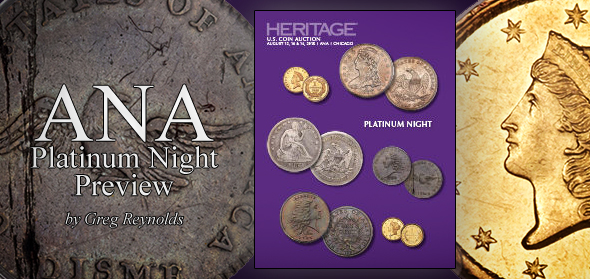
Coin Rarities & Related Topics: News and Analysis regarding scarce coins, coin markets, and the coin collecting community #288
A Weekly CoinWeek Column by Greg Reynolds….
Heritage often conducts official auctions at FUN, Central States, and ANA Conventions, and a Platinum Night event for U.S. coins is typically included. This year, Heritage and Stack’s-Bowers are each conducting official auctions in conjunction with the ANA Convention near Chicago, in Rosemont, Illinois. An assortment of rare U.S. coins, patterns, and American Colonials will be offered in this summer’s Platinum Night event on Wednesday, August 12.
There will also be Platinum Night sessions for U.S. paper money and for world coins, each of which will be held on August 13. This year, there are not large collections of U.S. coins dominating the Platinum Night event of Aug. 12. There are important sets of particular types. There are various consignments of small numbers of rarities. There is an assortment of noteworthy items, from many different consignors.
In this auction, the two rarest silver coins are both half dollars. One of four reported 1853-O ‘No Arrows’ Liberty Seated half dollars is featured. This one is PCGS graded VG-08 and was auctioned by Stack’s-Bowers in August 2012. In November 2014, Stack’s-Bowers auctioned a PCGS graded Good-06 coin for $246,750.
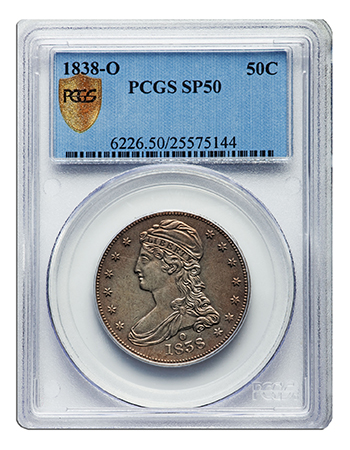 Around ten 1838-O half dollars are known. These are the first half dollars that were struck at a Branch U.S. Mint and are probably the first special strikings at the New Orleans Mint. Reports suggest that there could be 1838-O dimes that were specially struck, though I have never seen one. A specially struck 1839-O dime has been analyzed. (Clickable links are in blue.)
Around ten 1838-O half dollars are known. These are the first half dollars that were struck at a Branch U.S. Mint and are probably the first special strikings at the New Orleans Mint. Reports suggest that there could be 1838-O dimes that were specially struck, though I have never seen one. A specially struck 1839-O dime has been analyzed. (Clickable links are in blue.)
It is interesting that the current Heritage catalogue refers to this Boyd-Byers 1838-O half as having previously been in the collection of Charles Cass, which Stack’s auctioned in 1957, though the Byers catalogue in 2006 suggests that the Cass 1838-O is different from the Byers 1838-O. I cannot immediately access a catalogue of the Cass Collection, the Stack’s “Empire” sale of November 1957. Are the pictures therein clear enough for definitive matching?
In any event, this Boyd-Byers 1838-O is PCGS graded 50. It was not certified when Stack’s (NY) auctioned it as part of the George Byers Collection in October 2006 for $253,000. In May, the Eliasberg-Gardner NGC graded 64, 1838-O brought $646,250.
In October 2006, I covered the sale of the Buddy Byers Collection for Numismatic News newspaper. A collector bought this 1838-O at that sale and he then came very close to completing a collection of all copper, nickel and silver, classic U.S. coins.
This 1838-O is an excellent coin. For a 50 grade coin, it is more than very attractive. The toning is appealing and there are not many distracting marks. Indeed, it appears much more attractive in actuality than it appears to be in published images.
There are more than a few bust and Liberty Seated half dollars that are truly rare. Although Walking Liberty half dollars are common overall, many are elusive in the gem quality range, MS-65 and higher grades. For decades, there has been intense demand for gem Walkers
Eric Lane’s Walkers
Eric Lane’s set of Walking Liberty Half Dollars, as “The Cajun Collection,” is one of the five “All-Time Finest” sets of Walkers in three different categories in the PCGS set registry. “A dozen Walkers in the set I really loved, one of the best sets of Walkers I have ever seen,” remarks John Albanese, the founder of CAC.
Although Gerald Forsythe’s set of Walkers, unsurprisingly, remains at the top of the “All-Time” and “current” PCGS registry set listings, the “High Desert” set was ranked second. In 2012, at least two major conventions, there was a “showdown” between the Forsythe and “High Desert” sets.
It seems that the “High Desert” set is no longer listed in the PCGS registry, though I am unaware of it having been sold in the interim. It would rank second or third in the ‘all-time’ list if the public record of the “High Desert” set had not been removed from view by someone at PCGS, presumably at the request of the owner of the set.
In any event, Eric Lane’s collection is the best set of Walkers that has been available at auction in many years. It could possibly be the best set of Walkers that has ever been offered at auction, although the Forsythe and “High Desert” sets are clearly superior.
 The 1917 with ‘S’ mintmark on the obverse (front) is a highlight. Later in 1917, the design of the Walking Liberty half dollar was changed such that the mintmark was moved to the reverse (back), where it remained for the duration of the series. Walkers that were minted from 1941 to 1947 are very inexpensive.
The 1917 with ‘S’ mintmark on the obverse (front) is a highlight. Later in 1917, the design of the Walking Liberty half dollar was changed such that the mintmark was moved to the reverse (back), where it remained for the duration of the series. Walkers that were minted from 1941 to 1947 are very inexpensive.
This ‘Eric Lane’ 1917-S is PCGS graded as MS-67 and is CAC approved. It is the only 1917-S-Obverse that is PCGS graded as MS-67 and just three are PCGS graded as MS-66.
At the August 2013 ANA Convention, Stack’s-Bowers auctioned the “George Edward Collection,” PCGS graded MS-65, and CAC approved, 1917-S-Obverse for $30,550. The “George Edward” coin and the soon to be sold Eric Lane coin are noteworthy for not having the blatantly dipped appearance that tends to characterize most gem quality Walkers. On both, mottled, russet toning is clearly apparent, though neither has deeply toned.
The 1921 Philadelphia Mint issue and the 1921 Denver Mint Walker are key dates. Lane’s 1921 is PCGS graded MS-66 and CAC approved. It was formerly in the GBW registry set, a leader in its time. Just four 1921 Walkers are PCGS graded as MS-66 and the NGC has so graded two. CAC has approved two. A 1921 has has never been PCGS or NGC graded as MS-67, as far as I know.
The 1921-D in Eric Lane’s “Cajun” registry set is likewise PCGS graded MS-66, CAC approved and formerly in the GBW set. As with the 1921, there are no 1921-D Walkers that are PCGS or NGC graded as MS-67 or even as “MS-66+”!
After the 1919-D, the 1921-S is the foremost condition rarity in the gem quality range, MS-65 and higher grades. The Lane 1921-S is PCGS graded MS-65 and CAC approved.
The 1918-D is a well known condition rarity. The Lane 1918-D, also previously in the GBW set, is PCGS graded MS-66, CAC approved, and likely to be among the finest known. Neither PCGS nor NGC has assigned a grade higher than 66 to a 1918-D Walker. Also, this coin is the only 66 grade 1918-D to be CAC approved.
20th Century Silver
Collectors of Walkers often like Mercury dimes, which were designed by the same artist, A. A. Weinman. The 1916-D is the key to the series of Mercs and only eight are PCGS graded MS-67 with a ‘full bands’ designation. One is in this auction. I have not seen it, nor have I seen many of the coins mentioned in this discussion. As always, coin buyers are encouraged to consult experts before bidding on coins that the respective bidders regard as costing significant amounts of money.
The 1918/7-S overdate is a key to the series of Standing Liberty quarters (SLQs). In this auction, there is one that has a full head. It is PCGS graded MS-63, though interested collectors should, before bidding, hire an expert to closely examine this coin. SLQs with noticeable friction are sometimes assigned a grade of MS-63 by PCGS or NGC.
 Finding a 1926-D SLQ with a sharp head and shield is especially difficult. The only one that is PCGS graded MS-67, with a ‘full head’ designation, is being offered. Heritage auctioned this exact same coin for $105,750 in April 2014.
Finding a 1926-D SLQ with a sharp head and shield is especially difficult. The only one that is PCGS graded MS-67, with a ‘full head’ designation, is being offered. Heritage auctioned this exact same coin for $105,750 in April 2014.
Some of the same people who collect SLQs and Walkers are interested in Barber half dollars. One of the most famous of all Barber half dollars is the Duckor 1904-S, which is PCGS graded MS-67 and CAC approved. Indeed, Dr. Steven Duckor formed the all-time greatest set of Barber half dollars When Heritage auctioned Duckor’s set in August 2010, an auction record for a Barber half dollar was set when this coin realized $138,000!
PCGS has graded three 1904-S halves as MS-67, two of which are CAC approved. The third, the Norweb 1904-S, is owned by Dr. Peter Shireman and I do not know whether he ever submitted it to CAC.
The Emery-Nichols-Hugon 1904-S was NGC graded MS-67 when it realized $92,000 on January 12, 2005 and PCGS graded MS-67 when it brought $126,500 in January 2011. It is a great coin. The Duckor 1904-S was previously in the James A. Stack, Sr. Collection, and was sold by Stack’s (NY) in 1975.
Many of Dr. Duckor’s half dollars were pedigreed to epic collections of Barber halves that had been formed earlier, especially Emery-Nichols. David Akers attended the sale of the Emery-Nichols Collection by Bowers & Merena in 1984.
While there, David Akers purchased several Barber halves for his own personal collection. Akers also personally collected One Dollar Gold coins. Over a period of many years, he sold large portions of both sets to Dr. Steven Duckor.
Duckor One Dollar Gold Coins
In this ANA auction, Heritage will sell Dr. Duckor’s set of One Dollar Gold pieces. Although far from complete, it is the ‘current finest’ set in the PCGS set registry. Dr. Duckor intended to collect coins that grade 65 or higher. If the highest graded of a date by PCGS is “MS-64,” Duckor would seek a PCGS graded MS-64 coin of that date. He refused to consider coins that grade less than MS-64. So, Dr. Duckor never planned to complete the set.
Most of the One Dollar Gold coins in Duckor’s set are PCGS graded MS-67 or -68. According to data in the PCGS set registry, Duckor’s set has a “weighted” grade point average of “67.175.” Every single coin in Duckor’s set is CAC approved.
The PCGS graded MS-65+ 1849-O has a CAC gold sticker, which means that experts at CAC have determined that this coin merits a grade that is at least in the middle of the MS-66 range. There is a significant chance that this is the finest known 1849-O.
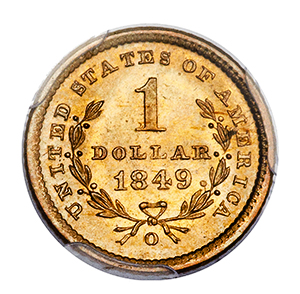 “The best set of One Dollar Gold coins that I have ever seen,” declares John Albanese, “not surprising since most of them came from David Akers. The mintmarked type 2’s were amazing; there will be very competitive bidding for those. ”
“The best set of One Dollar Gold coins that I have ever seen,” declares John Albanese, “not surprising since most of them came from David Akers. The mintmarked type 2’s were amazing; there will be very competitive bidding for those. ”
Type 2 One Dollar Gold coins were minted from 1854 to 1856. The 1855-D is the rarest Type 2 One Dollar Gold piece. It is the only Type 2 gold dollar that was struck at the branch of the U.S. Mint that was in Dahlonega, Georgia.
The Bass-Duckor 1855-D is tied for highest certified, one of two that PCGS has graded MS-64. NGC has graded two as MS-64 as well. CAC has approved two, including the Bass-Duckor coin. When the Goldbergs auctioned this same coin in February 2007, it brought $149,500.
The 1856-S is the last of the Type 2 One Dollar Gold pieces and the only Type 2 issue that was struck in San Francisco. The Duckor-Akers 1856-S was formerly owned by Donald Kutz, who is an accomplished collector of early 20th century gold coins and has had a long time interest in Buffalo nickels. Kutz has formed highly ranked, PCGS registry sets. His set of Indian Head quarter eagles is ranked as the “All-Time Finest.” I am surprised, though, that Kutz ever owned this coin.
The Duckor-Kutz-Akers 1856-S is PCGS graded MS-64 and CAC approved. Earlier, it was in the January 2010 Platinum Night event. Matt Kleinsteuber then examined it, “special for what it was, very nice for a ’56-S, neat to see a true mid-grade unc., really well struck for an 1856-S, with a real cool re-punched S”!
The 1856-S is probably rare in all grades. Most of the pieces is Duckor’s set are condition rarities, rather than rarities in absolute terms. The 1855-D, though, is even rarer than the 1856-S, and is very rare overall.
1849-C ‘Open Wreath’ Dollar
The rarest, widely discussed variety in the series of U.S. One Dollar Gold pieces is the 1849-C ‘Open Wreath,’ of which five survive. On these, the wreath is shorter and seemingly wider; there is more space between the two tips than there is on the vast majority of surviving 1849-C One Dollar Gold coins, which are of the ‘close wreath’ variety. The finest known 1849-C ‘Open Wreath’ is in this Platinum Night event.
This same coin was just in the Heritage ‘Central States’ Platinum Night even in April. It was then NGC certified as “MS-63 Prooflike,” which is the same certification it had when David Lawrence Rare Coins auctioned it during July 2004. Although it was sold along with the gold coins that were in the Richmond Collection, this coin was not in the Richmond Collection, which never contained an 1849-C ‘Open Wreath’ One Dollar Gold piece.
In July 2004, this 1849-C ‘Open Wreath’ brought $690,000, an auction record for a One Dollar Gold piece. In April 2015, it went for $493,500. Since April, it has been downgraded and PCGS certified as MS-62 without a ‘Prooflike’ designation. It does not have a CAC sticker.
Oliver Jung Wreath Cent
U.S. coins were first minted in 1793. There were three distinct design types of large cents minted in that year: Chain, Wreath and Liberty Cap.
One of the finest known Wreath Cents, of any die pairing, is in this sale. It is PCGS certified as ‘MS-66 Red & Brown’ and it was earlier in the epic type set of Oliver Jung, which ANR auctioned on July 23, 2004 in New York. Coins from Jung’s second set, which was a ‘work in progress,’ were auctioned by Heritage last year, at the summer 2014 ANA Convention. This cent was a highlight of Jung’s first set, which is one of the greatest type sets of all time.
This Jung Wreath Cent has a CAC sticker and CAC has approved just three Wreath Cents in the gem range, including one as ‘MS-66-Brown.’ The identity of the current consignor is not being revealed. It is odd that Jung’s name was not mentioned in the catalogue description. This coin realized $207,000 on July 23, 2004 and will certainly attract bids that are much higher than that amount on August 12, 2015.
Proof Early, Liberty Seated Quarters
Pre-1853, Proof Liberty Seated quarters are extremely rare. There are four in this Platinum Night event.
I know the Pittman-Kaufman-Gardner 1844 well. I have inspected her in May 1998, January 2008, January 2009, August 2009 and June 2014. Note the following auction results for the same coin: 01/08 $322,000, 01/09 $299,000, 07/09 $276,000, 08/13 $258,500, and 06/14 $182,125. Although a great coin, it has become too stale. It just does not make sense for the same coin to be sold every six to eighteen months. It is best for a collector to hold onto a coin for at least five years.
During all the auction appearances from 2009 to 2014, this 1844 was NGC certified as Proof-66 and CAC approved. It has since been downgraded by PCGS to 65 and now has a CAC gold sticker.
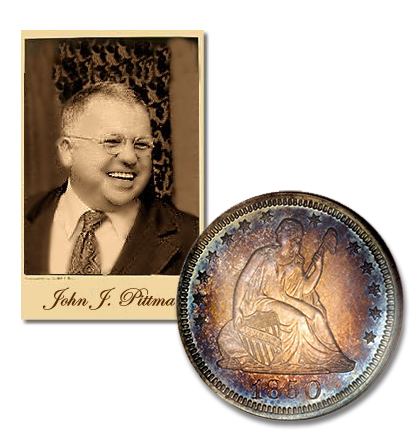 A PCGS certified and CAC approved Proof-64 1845 is not pedigreed by the cataloguers. The Pittman-Gardner 1849 is still on my mind, as I just saw it in May in the Gardner III sale. Then and now, it is PCGS certified as Proof-66 and CAC approved. The wonderful blue toning is memorable, and had an impact when I first saw it in 1998. This coin brought $47,000 in May 2015, a weak to moderate price.
A PCGS certified and CAC approved Proof-64 1845 is not pedigreed by the cataloguers. The Pittman-Gardner 1849 is still on my mind, as I just saw it in May in the Gardner III sale. Then and now, it is PCGS certified as Proof-66 and CAC approved. The wonderful blue toning is memorable, and had an impact when I first saw it in 1998. This coin brought $47,000 in May 2015, a weak to moderate price.
The Pittman-Kaufman-Gardner 1850 is a legendary coin. In July 2013, I wrote an article about it. In Heritage auctions, it appeared on Jan. 10, 2008, on Aug. 9, 2013, on June 23, 2014, and on Jan. 7, 2015. It will appear again on Aug. 12, 2015.
When it was in the Pittman II sale in May 1998, this 1850 was slightly brighter. It has naturally toned down a little since May 1998, which is not unusual. Silver coins keep toning, a little every day, though most changes in toning are not noticeable for years. It remains a very pretty coin with terrific natural toning.
Although it was graded 68 soon after the Pittman II sale, it is unsurprising that it was downgraded in 2014 and PCGS certified as Proof-67. When it was NGC graded as 68, it did not have a CAC sticker; it does now. There is wide agreement among relevant experts that the current 67 grade is appropriate.
In Jan. 10, 2008, shortly before markets for rare U.S. coins peaked during the summer of 2008, this 1850 quarter sold for $460,000. On Aug. 9, 2013, it brought $258,500. In June 2014, it realized $223,250, a moderate price. It does not make sense to equate the market levels for Proof Liberty Seated coins of the last five years to market levels that prevailed from 2005 to the middle of 2008. Demand and supply factors have changed substantially, especially for pre-1856, Proof Liberty Seated coins.
In 1998, David Akers implied that only two Proof 1850 quarters exist, though he allowed for the possibility that there could be three. The current Heritage catalogue lists four.
The Heritage cataloguer of this lot implies that Gene Gardner owned three of the listed four not long ago, and still owns the Richmond and Floyd Starr Proof 1850 quarters, which are both scheduled to be auctioned on Oct. 28. Moreover, it is suggested that there could be at least one additional Proof 1850 quarter, as four prior sighting are not entirely explained in the context of Heritage’s detailed list of four. The value of this coin might have been affected by Akers’ implication in 1998 that maybe two exist and the current view that four or five survive.
Pre-1793 American Items
The Oeschner-Partrick, Lord Baltimore Shilling is re-appearing in the upcoming Platinum Night session. A large part of the Donald Partrick collection was auctioned in January 2015 at the FUN Convention.
‘Lord Baltimore’ silver coins were probably made in 1659 and certainly circulated in the colony of Maryland during the 1660s. In January, this same coin brought $56,400, while NGC graded as AU-58, with a CAC sticker. It is now PCGS graded AU-58.
Although not as well documented as Lord Baltimore coins, Elephant tokens are curious and may have much historical significance. London Elephant tokens were struck in the late 1600s and are scarce, though obtainable. It would not be difficult to purchase one of the thick planchet pieces for less than $1500. A well circulated London Elephant token might very well sell for less than $550.
The Carolina Elephant tokens of 1694 are far rarer than London Elephant tokens. In terms of technical factors and surface quality, Eric Newman’s Carolina Elephant token that was auctioned in the Newman sale of May 2014 is extremely impressive. This same piece is re-appearing in this upcoming Platinum Night event. In 2014, it was NGC graded EF-45, and it has since ‘crossed’ into a PCGS holder. It was CAC approved before it realized $47,000 in 2014.
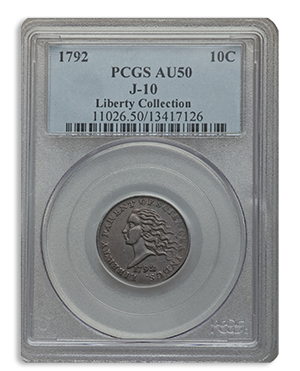 A Lord Baltimore Shilling, a Carolina Elephant token and a 1792 dime pattern are consistent with the theme that there are an assortment of rarities in this auction. A PCGS graded AU-50, 1792 dime pattern (“disme”) in copper will attract attention. Although this pattern has a reeded edge, it is unusual for anyone to collect 1792 patterns by edge variety. For reeded edge and plain edge pieces, a total of more than twenty 1792 dime patterns in copper are known, and three are known that were struck in silver, according to Saul Teichman.
A Lord Baltimore Shilling, a Carolina Elephant token and a 1792 dime pattern are consistent with the theme that there are an assortment of rarities in this auction. A PCGS graded AU-50, 1792 dime pattern (“disme”) in copper will attract attention. Although this pattern has a reeded edge, it is unusual for anyone to collect 1792 patterns by edge variety. For reeded edge and plain edge pieces, a total of more than twenty 1792 dime patterns in copper are known, and three are known that were struck in silver, according to Saul Teichman.
In January 2015, the NGC graded EF-40, Partrick 1792 disme in copper brought $211,500. In May 2014, the NGC graded AU-55, Newman piece sold for $499,375.
Wass Molitor ‘Large Head’ $20 coin
The Carter-Riverboat, 1855 Wass Molitor $20 gold coin is somewhat famous. Wass, Molitor & Co. was a private assaying firm that produced pioneer gold coins in San Francisco during the era of the California Gold Rush. Wass Molitor coins are dated 1852 or 1855. Wass Molitor produced $5, $10, $20 and $50 gold coins.
In the Heritage catalogue, there are identified four 1855 Wass Molitor $20 gold coins with a large head of Miss Liberty on the obverse (front), similar to the regular U.S. Mint Liberty Head Double Eagles of the time period. On Wass Molitor coins, the‘Small Head’ design appears much different from the ‘Large Head’ design.
Just a few weeks ago, Heritage auctioned a NGC graded AU-53, Wass Molitor ‘Small Head’ $20 for $47,000. Could there be thirty such ‘Small Head’ twenties in existence?
Not long ago, it was thought that just three ‘Large Head’ twenties survived. Moreover, Wayne Burt, Saul Teichman and David Stone maintain that the currently offered, Carter-Riverboat piece is of a die pairing that is different from that of the other three, which were all struck from the same pair of dies. Evidently, a different reverse die was used to strike the Carter-Riverboat ‘Large Head’ $20 piece, a reverse die that had also been used to produce some of the Wass Molitor ‘Small Head’ $20 gold coins.
This exact same coin was earlier part of the famous Amon Carter Collection, which Stack’s auctioned in 1984, and later part of “The Riverboat Collection,” which Heritage auctioned in April 2014.
When I reviewed the results of that sale, I omitted mention of this coin, as it requires so much explanation. Given the rarity and very infrequent appearances of ‘Large Head’ Wass Molitor twenties, it is difficult to interpret the $558,125 result in 2014, which was at least somewhat strong.
More Rare Gold
It is not practical to list or even allude to all the gold rarities in this Platinum Night event. The “Duquesne” set of Liberty Head double eagles contains many rarities, including an 1854-O, an 1856-O and an 1870-CC, plus the Proof-only issues of 1883, 1884 and 1887. The Trompeter set of Proof Liberty Head half eagles is noteworthy. There are thousands of significant numismatic items in the whole Heritage auction extravaganza at the ANA Convention.
©2015 Greg Reynolds





Thanks for your comments! I wish you had called me to discuss the set. See you at Chicago. sd